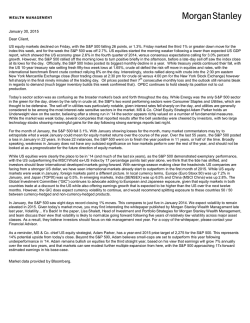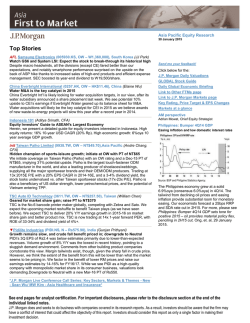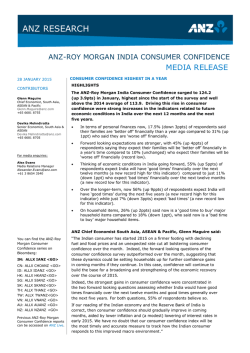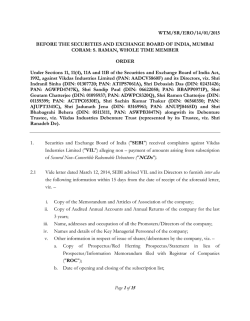
Wealth and Taxes: Planning for 2015
november 2014 Wealth and Taxes: Planning for 2015 2014 YEAR-END TAX PLANNING GUIDE Over the past few years, the traditional year-end tax planning season has been fraught with uncertainties caused by a tendency for lastminute decisions on economic policy legislation in Washington. This year, with no significant tax law changes anticipated as of this writing, year-end tax planning should be somewhat easier. Last year, the American Taxpayer Relief Act (ATRA) prevented income-tax increases for many taxpayers, although those with higher incomes were not as lucky. Adding to their higher tax burden was a Medicare surtax and a new tax on net investment income. ATRA also made permanent the elevated estate, gift and generation-skipping tax exemptions and indexed them for inflation in subsequent years. While the changes made by ATRA are “permanent,” they still may be subject to future legislative changes, which can occur in any year. It behooves clients to review their individual situation every year, regardless of the tax environment. In this new era of tax preparedness, this planning guide outlines a number of strategies available to investors. Your Morgan Stanley Financial Advisor or Private Wealth Advisor can work with you and your personal tax and legal advisors to help determine strategies that may be beneficial to you. Table of Contents 2 3 Tax Policy: A New Era in Tax Preparedness Ten Year-End Tax Strategies to Consider 6 Case Study 7 Checklist 2014 YEAR-END TAX PLANNING GUIDE Tax Policy: A New Era in Tax Preparedness In recent years, we have seen a greater tendency for last-minute decisions on economic policy legislation in Washington. The American Tax Payer Relief Act (ATRA) passed at the last hour, as did debt ceiling and budget legislation, each of which directly or indirectly affected tax policy and caused uncertainty for investors. Other issues that could affect the economy include the Affordable Care Act, economic and political conditions in other countries, and foreign policies. This year, however, no significant tax law changes are anticipated as of this writing, alleviating some of the uncertainty. Nonetheless, the tax cuts enacted during the Bush regime are no longer available and investors may need to be prepared for higher taxes. For 2014, higher income taxpayers may be subject to a 3.8% Net Investment Income Tax on their investment income and Additional Medicare Tax of 0.9% on compensation. The top effective tax rate is now 43.4% on dividends, interest and short-term capital gains, and 23.8% for qualified dividends and long-term capital gains. The estate tax, with a new slightly higher rate of 40%, has a new “permanent” exemption of $5 million (2011 dollar-indexed for inflation), increased to $5.34 million for 2014 and $5.43 million in 2015. Tax Rates Effective in 2014 and 2015 Taxable Income Ranges (Married Filing Jointly) Income Tax Rates 2014 2015 (Projected) 2014-2015 Over $457,600 Over $464,850 $405,100 – $457,600 $411,550 – $464,850 35% $226,850 – $405,100 $230,450 – $411,550 33% $148,850 – $226,850 $151,200 – $230,450 28% $73,800 – $148,850 $74,900 – $151,200 25% $18,150 – $73,800 $18,450 – $74,900 15% $0 – $18,150 $0 – $18,450 10% Top effective dividend rate (nonqualified) 1 43.4% Top effective dividend rate (qualified) 1 23.8% Top effective maximum short-term capital gains rate 43.4% Top effective long-term capital gains rate1 23.8% Estate tax rate Estate & gift tax exemption Source: IRS 1 2 39.6% Includes Medicare Investment Income Tax of 3.8%. Morgan Stanley | 2014 40% $5.34M in 2014 and $5.43M in 2015 2014 YEAR-END TAX PLANNING GUIDE Ten Year-End Tax Strategies to Consider Prudent investing should include a review of one’s investments to help ensure that they are meeting stated financial objectives. With markets changing daily and political pressures and policies affecting the economy, investors should consider being even more vigilant in reviewing and adjusting their asset allocation and overall portfolio strateg y to keep investments aligned with goals. 1. Max out retirement plans. It might make sense to fully fund your company retirement accounts and/or IRAs. The primary advantage of participating in a Traditional IRA is that the contribution may be tax deductible; similarly, if you are contributing to a 401(k) plan, your contribution may be made on a pretax basis. If your taxable income is less, the amount of income tax you owe for that year might also be reduced. And because these are tax-deferred accounts, you do not pay income taxes on any earnings on your investments until you withdraw funds. You have until April 15, 2015 to fund your IRA for 2014. Consult your employer and tax advisor to determine the deadline for contributing to your company retirement plan. 2. Consider a Roth IRA conversion. While income limits may preclude some investors from contributing to a Roth IRA, anyone can do a Roth Conversion by converting eligible funds from a Traditional IRA or employer-sponsored retirement plan to a Roth IRA. (Roth IRA contributions are made with aftertax dollars, and qualified withdrawals in retirement are tax free.1 When you convert, you must pay taxes on the amount converted as ordinary in- 2014 Retirement Plan Contribution Limits Type of Plan Under Age 50 Traditional /Roth IRA 2 401(k)/403(b)/457(b)/SAR-SEP 3 SIMPLE Age 50 or Older $5,500 $6,500 $17,500 $23,000 4 $12,000 $14,500 4 Contributions to an IRA are dependent upon your age, earned income and access to an employer-sponsored retirement plan. 3 Only SAR-SEP plans established before 1997 may allow employees to make pre-tax contributions. 4 If permissible under the terms of your employer-sponsored retirement plan. 2 come for that year.) This year, the IRS provided guidance on the allocation of after-tax amounts to rollovers, stating that after-tax money in a 401(k) can be directly converted to a Roth IRA tax-free. Taxpayers who have potentially taxable estates should seriously consider the Roth IRA conversion option, as it could make a potentially significant future wealth transfer more tax efficient. 3. Review highly appreciated assets. Even though the capital gains tax rates have increased for high income taxpayers, the capital gains rates for most taxpayers are still significantly less than ordinary income tax rates. Consult your tax advisor about whether shifting to investments that generate capital gains instead of ordinary income would be a good strategy for you. Remember too that diversification is important. When dealing with large concentrated stock or highly appreciated positions, be sure to weigh the risks of holding the large position versus the benefits of diversification. If gradual diversification is needed, trim before year-end to spread the capital gains impact over multiple years. 4. Give increased attention to buy-and-hold strategies. Higher capital gains tax rates make buyand-hold strategies more attractive; the higher the tax rate, the more valuable the strategy. Similarly, it becomes more important to harvest tax losses in order to shelter gains that otherwise would be taxed at the higher rate. Equity unit investment trusts (UITs) are generally unmanaged investments with holding periods ranging from 15 months to five years that can help increase your tax efficiency since there are less short-term capital gains because the underlying securities are bought and held. 1 estrictions, penalties and taxes may apply. R Unless certain criteria are met, Roth IRA owners must be 59 ½ or older and have held the Roth IRA for five years before completely tax /penalty-free withdrawals are permitted. Morgan Stanley | 2014 3 2014 YEAR-END TAX PLANNING GUIDE 5. AUGMENT YOUR TAX-ADVANTAGED INVESTMENTS WITH MUNICIPAL BONDS. Municipal bonds, which are typically free from federal, state and local taxes, are one of the most efficient investments available for defending against current and potentially higher tax rates. Even though income tax rates rose for high income taxpayers, interest income earned on municipal bonds remains largely unaffected. Because there is a wide range of state-specific issues, credit ratings and maturities from which to choose, be sure to work with your Morgan Stanley Financial Advisor or Private Wealth Advisor when adding exposure to this asset class. 6. Consider redeploying assets to a variable annuity. In a rising tax environment, the tax deferral feature of annuities becomes increasingly attractive. Diversifying your retirement portfolio with a variable annuity may provide taxdeferred growth potential, guaranteed lifetime income, increased retirement savings, equity upside potential and a death benefit for named beneficiaries. Remember, though: withdrawals from variable annuities will be taxed as ordinary income. 4 Morgan Stanley | 2014 Guiding principle: It’s not what you earn; it’s what you keep. Therefore, it’s always appropriate to consider the range of tax-free, taxdeferred and tax-advantaged investment strategies. 7. Consider professionally managed and tax-advantaged invest- Exchange-Traded Funds (ETFs) generally pass through lower short-term capital gains because investor shares are traded on an exchange, resulting in lower portfolio turnover. These types of funds can help blunt the effects of any future increases in taxes and capital gains rates. ment strategies (or the use of tax-optimization strategies for managed accounts). Now is a good time to evaluate the overall tax efficiency of investments in your accounts. Beyond municipal bonds, consider tax-efficient mutual funds or separately managed accounts (SMAs) that aim to limit the number of taxable events within your portfolio. These may include tax-managed funds and tax-exempt or low turnover index funds with minimal capital gains distributions. Other options may also include tax-aware SMAs that limit tax exposure through tailored individual holdings. Lastly, within Select UMA (Unified Managed Account), consider our optional tax management services feature that builds on the tax advantages inherent in SMAs utilizing taxloss harvesting, customizable realized gain limits and other techniques to help manage tax liabilities at the portfolio level. 8. Review dividend distributions of your current portfolio. Qualified dividend income tax rates for most taxpayers remained the same with the passage of ATRA. However, for higher income taxpayers, the 3.8% net investment income surtax has effectively increased the qualified dividend top tax rate to 23.8%. These rates are still lower than the ordinary income tax rates for most taxpayers, so consult with your Morgan Stanley Financial Advisor or Private Wealth Advisor and your tax advisor about whether you should adjust your investment holdings to achieve greater income-tax efficiency. 2014 YEAR-END TAX PLANNING GUIDE Gifting and Legacy Planning 9. E n g ag e i n l eg ac y p l a n n i n g and gifting. Even though the estate and gift tax exemptions were made permanent and adjusted for inflation under ATRA, all investors, regardless of their level of wealth, should have an estate plan in place that reflects their current and ultimate wealth transfer goals and objectives. Taxpayers with taxable or potentially taxable estates who are in an economic position to do so and would like to benefit their heirs should consider making lifetime gifts to those heirs now, which may be a potentially more tax-efficient wealth transfer strategy. 10. CONSIDER A SECURITIES BASED LOAN OR LINE OF CREDIT FOR TAX OBLIGATIONS. Using cash or liquidating assets could disrupt your investment strategy and trigger capital gains taxes or transaction fees. A securities based loan or line of credit can generally be established in just a few days, can be easy to set up, and offers competitive rates with typically no fees.2 Speak to your Financial Advisor or Private Wealth Advisor about keeping your investment portfolio intact and paying your taxes with a securities based loan or line of credit. You are entitled to transfer up to $14,000 per recipient in 2014 and 2015 without incurring any federal gift tax. This is an annual exclusion that is in addition to the lifetime exemption amount of $5.34 million in 2014 and $5.43 million in 2015. Spouses together may gift up to $28,000 per recipient annually in addition to their lifetime exclusion (the annual exclusion amount is separate from the one-time gift and estate tax exemption, and is not scheduled to change next year). You can create and fund an irrevocable life insurance trust, or ILIT, with annual gifts to the trust, thereby maximizing the benefits of the annual gift tax exclusion. In addition, you can use all or some of your lifetime exemption to buy additional insurance to further leverage your gift. Consider an “accelerated” gifting strategy for your 529 college savings plan contributions to help fund a loved one’s higher education and potentially reduce your taxable income and your taxable estate — without giving up control of your assets. A special provision in the tax code allows you to take five years of gift tax exclusions in a single year — up to $70,000 ($140,000 for a married couple) for each beneficiary — by making a contribution into a 529 plan.1 You might also consider unlimited tax-free gifts in the form of payments for another individual’s tuition expenses and/or unreimbursed medical expenses made directly to the educational institution or medical provider. Consider charitable gifts of appreciated stock and other illiquid assets. For gifts to public charities, as long as the investment has been owned for at least one year and has appreciated in value, the owner may deduct the full market value without having to pay tax on the appreciation. A donor advised fund (DAF), such as Morgan Stanley Global Impact Funding Trust (GIFT), is a tax-efficient way of donating taxable stock, mutual funds or other appreciated assets. A tax deduction can be claimed for the entire market value of the donated assets. A DAF can be funded in years when the deduction will have the most impact, and distributions to the selected charities may be made in later years. Conduct a review with your Financial Advisor or Private Wealth Advisor, coordinated with your personal tax and legal advisors, to ensure that your estate plans, trusts, insurance contracts and retirement accounts are complete, up-to-date and reflective of your current desires and goals. 1 No further annual exclusion gifts and/or generation-skipping transfers to the same beneficiary by the donor may be made over the same five-year period, and the gift must be reported as a series of five equal annual gifts. If the donor dies within the five-year period, a portion of the gifted amount will be included in the donor’s estate for estate tax purposes. If you revoke the account, its value comes back into your taxable estate. 2 In certain instances, clients may be charged legal or documentation fees by third parties. Clients may also be charged a fee for the issuance of a letter of credit. Morgan Stanley | 2014 5 2014 YEAR-END TAX PLANNING GUIDE Case Study Consider this hypothetical example to better understand current tax laws. Steve and Robin Green are a hypothetical couple with three children. In 2014, they will earn $500,000 in wages, plus an additional $315,000 from non-qualified stock options and investment income. • They are in the top tax bracket, which this year is 39.6%. • T he rate they pay on long-term capital gains is 20%. • They are subject to the 3.8% Net Investment Income Tax and the 0.9% Additional Medicare Tax as a result of their high income. • Because of their high income, their per- sonal exemptions are eliminated, and their itemized deductions are reduced. The strategies discussed in this brochure might help minimize the impact of current tax laws. Contact your Financial Advisor or Private Wealth Advisor to determine which strategies might be appropriate for you. Here’s how Mr. and Mrs. Green’s tax liability looks for 2014 INCOME 2014-2015 Wages $500,000 Non-Qualified Stock Options $100,000 A. The Greens’ income B. Their itemized deductions reflect a reduction for high-income families C. The Greens also cannot claim personal exemptions Interest Income $25,000 Qualified Dividends $50,000 Short-Term Capital Gains $40,000 Long-Term Capital Gains $100,000 Adjusted Gross Income $815,000 A -$82,550 B Less Exemptions -$0 C Taxable Income $732,450 D. Reflects a tax rate of 39.6% E. Qualified dividends are taxed at 20% F. Joint filers with an AGI over $250k DEDUCTIONS Less Itemized Deductions G. They also incur an Additional Medicare Tax of 0.9%. TAXES Regular Tax $177,404 D Qualified Dividends $10,000 E Long-Term Capital Gains $20,000 Net Investment Income Tax $8,170 F Additional Medicare Tax $3,150 G US Tax Liability Hypothetical example for illustrative purposes only 6 Morgan Stanley | 2014 $218,724 ($200k for single filers) incur 3.8% on interest, dividends, and all capital gains, which creates an effective tax on qualified dividends and long-term capital gains of 23.8% 2014 YEAR-END TAX PLANNING GUIDE Checklist Ten Strategies to Prepare for the New Tax Era Strategy to Consider Next Steps Max out retirement plans Consider a Roth IRA conversion Review highly appreciated assets Give increased attention to buy-and-hold strategies Augment your tax-advantaged investments with municipal bonds Consider redeploying assets to a variable annuity Consider professionally managed and tax-advantaged investment strategies (or the use of tax-optimization strategies for managed accounts) Review dividend distributions of your current portfolio Engage in gifting and legacy planning Consider using a securities based loan to finance your tax liability Morgan Stanley | 2014 7 2014 YEAR-END TAX PLANNING GUIDE Morgan Stanley Smith Barney LLC does not accept appointments nor will it act as a trustee, but it will provide access to trust services through an appropriate third-party corporate trustee. This material does not provide individually tailored investment advice. It has been prepared without regard to the individual financial circumstances and objectives of persons who receive it. The securities discussed in this material may not be suitable for all investors. Morgan Stanley Wealth Management (“Morgan Stanley”) recommends that investors independently evaluate particular investments and strategies, and encourages investors to seek the advice of a financial advisor. The appropriateness of a particular investment or strategy will depend on an investor’s individual circumstances and objectives. Tax laws are complex and subject to change. Morgan Stanley Smith Barney LLC, its affiliates and its Financial Advisors and Private Wealth Advisors do not provide tax or legal advice and are not “fiduciaries” (under ERISA, the Internal Revenue Code or otherwise) with respect to the services or activities described herein except as otherwise provided in a written agreement with Morgan Stanley. Individuals are encouraged to consult their tax and legal advisors (a) before establishing a retirement plan or account, and (b) regarding any potential tax, ERISA and related consequences of any investments made under such plan or account. Morgan Stanley Smith Barney LLC and its affiliates and their employees (including Financial Advisors and Private Wealth Advisors) are not in the business of providing tax or legal advice. These materials and any statements contained herein should not be construed as tax or legal advice. Individuals should consult their personal tax advisor or attorney for matters involving taxation and tax planning and their attorney for matters involving personal trusts and estate planning. Companies paying dividends can reduce or cut payouts at any time. Bonds are affected by a number of risks, including fluctuations in interest rates, credit risk and prepayment risk. In general, as prevailing interest rates rise, fixed income securities prices will fall. Bonds face credit risk if a decline in an issuer’s credit rating, or creditworthiness, causes a bond’s price to decline. Finally, bonds can be subject to prepayment risk. When interest rates fall, an issuer may choose to borrow money at a lower interest rate, while paying off its previously issued bonds. As a consequence, underlying bonds will lose the interest payments from the investment and will be forced to reinvest in a market where prevailing interest rates are lower than when the initial investment was made. NOTE: High yield bonds are subject to additional risks such as increased risk of default and greater volatility because of the lower credit quality of the issues. Interest on municipal bonds is generally exempt from federal income tax; however, some bonds may be subject to the alternative minimum tax (AMT). Typically, state tax-exemption applies if securities are issued within one’s state of residence and, if applicable, local tax-exemption applies if securities are issued within one’s city of residence. The tax-exempt status of municipal securities may be changed by legislative process, which could affect their value and marketability. Mutual Funds, Exchange-Traded Funds (ETFs), Unit Investment Trusts (UITs) and Variable Annuities are sold by prospectus. Investors should carefully read the prospectus which includes information on the investment objective, risks, charges and expenses along with other information before investing. To obtain a prospectus, please contact your Financial Advisor or Private Wealth Advisor. Please read the prospectus carefully before investing. Variable annuities are long-term investments designed for retirement purposes and may be subject to market fluctuations, investment risk and possible loss of principal. All guarantees are based on the claims-paying ability of the issuing insurance company. Taxable distributions (and certain deemed distributions) are subject to ordinary income tax and, if taken prior to age 59½, may be subject to a 10% federal income tax penalty. Early surrender charges may also apply. Withdrawals will reduce the death benefit and cash surrender value. Variable annuities are subject to market risk, will fluctuate in value and can lose money. © 2014 Morgan Stanley Smith Barney LLC. Member SIPC. If you are investing in a variable annuity through a tax-advantaged retirement plan such as an IRA, you will get no additional tax advantage from the variable annuity. Under these circumstances, you should only consider buying a variable annuity because of its other features, such as lifetime income payments and death benefit protection. Insurance products are offered in conjunction with Morgan Stanley’s licensed insurance agency affiliates. Investors should consider many factors before deciding which 529 Plan is appropriate. Some of these factors include: the Plan’s investment options and the historical investment performance of these options, the Plan’s flexibility and features, the reputation and expertise of the Plan’s investment manager, Plan contribution limits and the federal and state tax benefits associated with an investment in the Plan. Some states, for example, offer favorable tax treatment and other benefits to their residents only if they invest in the state’s own Qualified Tuition Program. Investors should determine if their home state offers a 529 Plan that may offer such favorable tax treatment and benefits to residents or beneficiaries of that state that may not be available to investors or beneficiaries of other states. Investors should consult with their tax or legal advisor before investing in any 529 Plan or contact their state tax division for more information. Morgan Stanley does not provide tax and or legal advice. Morgan Stanley Smith Barney GIFT, Inc. is an organization described in Section 501(c)(3) of the Internal Revenue Code of 1986, as amended, and Morgan Stanley Smith Barney Global Fund Trust is a donor-advised fund. Various divisions of Morgan Stanley Smith Barney LLC provide investment management and administrative services to Morgan Stanley Smith Barney GIFT. Borrowing against securities may not be suitable for everyone. You should be aware that securities-based loans involve a high degree of risk and that market conditions can magnify any potential for loss. Most importantly, you need to understand that: (1) Sufficient collateral must be maintained to support your loan(s) and to take future advances; (2) You may have to deposit additional cash or eligible securities on short notice; (3) Some or all of your securities may be sold without prior notice in order to maintain account equity at required collateral maintenance levels. You will not be entitled to choose the securities that will be sold. These actions may interrupt your long-term investment strategy and may result in adverse tax consequences or in additional fees being assessed; (4) Morgan Stanley Bank, N.A., Morgan Stanley Private Bank, National Association, or Morgan Stanley Smith Barney LLC (collectively referred to as “Morgan Stanley”) reserves the right not to fund any advance request due to insufficient collateral or for any other reason except for any portion of a securities-based loan that is identified as a committed facility; (5) Morgan Stanley reserves the right to increase your collateral maintenance requirements at any time without notice; and (6) Morgan Stanley reserves the right to call your securities-based loan at any time and for any reason. The proceeds from certain securities based loan products may not be used to purchase, trade or carry margin stock (or securities, with respect to Express CreditLine); repay margin debt that was used to purchase, trade or carry margin stock (or securities, with respect to Express CreditLine); and cannot be deposited into a Morgan Stanley Smith Barney LLC or other brokerage account. To be eligible for a securities based loan, a client must have a brokerage account at Morgan Stanley Smith Barney LLC that contains eligible securities, which shall serve as collateral for the securities based loan. Morgan Stanley Smith Barney LLC is a registered Broker/Dealer, Member SIPC, and not a bank. Where appropriate, Morgan Stanley Smith Barney LLC has entered into arrangements with banks and other third parties to assist in offering certain banking related products and services. Investment services are offered through Morgan Stanley Smith Barney LLC. Unless specifically disclosed in writing, investments and services offered through Morgan Stanley Smith Barney LLC are not insured by the FDIC, are not deposits or other obligations of, or guaranteed by, a bank and involve investment risks, including possible loss of principal amount invested. CRC1038411 11/14 PS7250560 CS 8059126 11/14
© Copyright 2025










